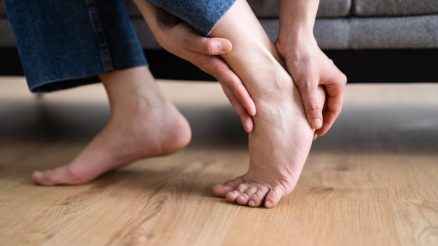Our feet carry us through life, enduring countless steps and supporting our entire body. Yet, they often get overlooked until something goes wrong. What many people don’t realize is that these often-neglected appendages can be powerful indicators of your overall health. From subtle changes in skin texture to persistent pain, your feet can offer valuable clues about underlying conditions, sometimes even before other symptoms appear.
Paying closer attention to your feet can empower you to catch potential health issues early, leading to timely diagnosis and treatment. Let’s explore some common foot signs and what they might be trying to tell you about your health.
1. Persistent Cold Feet: More Than Just the Weather
Do your feet feel perpetually cold, even when the rest of your body is warm? While chilly temperatures are an obvious culprit, persistent coldness in your feet can signal more significant health concerns:
- Poor Circulation: This is the most common reason. Reduced blood flow to the extremities can be a sign of peripheral artery disease (PAD), where arteries narrow and harden. PAD is often linked to high blood pressure, high cholesterol, and smoking, and it increases your risk of heart attack and stroke.
- Hypothyroidism: An underactive thyroid gland can slow down your metabolism, leading to a drop in body temperature and, consequently, cold feet. Other symptoms might include fatigue, weight gain, and dry skin.
- Raynaud’s Phenomenon: This condition causes blood vessels to narrow temporarily in response to cold or stress, leading to cold, numb, and discolored toes (and fingers).
2. Swollen Feet and Ankles: Edema’s Warning
Occasional swelling after a long day on your feet is normal. However, persistent or significant swelling (edema) in your feet and ankles can be a red flag:
- Fluid Retention: This is the most direct cause. It can be benign, like standing for too long or during pregnancy.
- Heart Problems: If your heart isn’t pumping blood effectively (congestive heart failure), fluid can back up in the lower extremities. Swelling often worsens throughout the day.
- Kidney Disease: Impaired kidney function can lead to an accumulation of salt and water in the body, causing swelling.
- Liver Disease: Severe liver disease can affect the production of albumin, a protein that helps keep fluid in your blood vessels, leading to fluid leakage into tissues.
- Deep Vein Thrombosis (DVT): Swelling in just one leg, often accompanied by pain, warmth, or redness, could indicate a blood clot in a deep vein. This is a medical emergency.
- Medication Side Effects: Certain medications, including some blood pressure drugs, antidepressants, and steroids, can cause swelling.
3. Numbness or Tingling (“Pins and Needles”): Nerve Signals
A temporary “pins and needles” sensation from sitting in an awkward position is harmless. But chronic numbness or tingling in your feet, often described as a “burning” or “prickling” sensation, warrants attention:
- Peripheral Neuropathy: Damage to the peripheral nerves is a common cause.
- Diabetes: High blood sugar levels can damage nerves over time, leading to diabetic neuropathy, which often starts in the feet.
- Vitamin B12 Deficiency: This essential vitamin is crucial for nerve health. A deficiency can cause nerve damage and symptoms like numbness.
- Pinched Nerve: A nerve compressed in your back or ankle can send radiating sensations down to your foot.
- Alcohol Abuse: Chronic heavy drinking can lead to alcoholic neuropathy.
4. Dry, Flaky, or Peeling Skin: Beyond Just Dryness
While dry skin on your feet can be due to lack of moisture, persistent dryness, flakiness, or peeling, especially between the toes or on the soles, might indicate:
- Athlete’s Foot (Tinea Pedis): This common fungal infection often presents with itching, redness, scaling, and sometimes blisters. It can spread easily.
- Eczema or Psoriasis: These chronic skin conditions can affect the feet, causing dry, red, itchy, and sometimes cracked patches.
- Thyroid Issues: As mentioned with cold feet, an underactive thyroid can lead to extremely dry, scaly skin all over the body, including the feet.
5. Nail Changes: A Window to Internal Health
Your toenails can offer surprising insights into your health:
- Thickened, Brittle, or Discolored Nails (Yellow/Brown): Often a sign of a fungal infection (onychomycosis). However, in rare cases, yellow nails can be associated with lung disease or lymphedema.
- “Spoon” Nails (Koilonychia): Nails that are thin, concave, and scoop upward can indicate iron deficiency anemia.
- Pitting or Ridges: Small depressions or horizontal ridges on the nails can be linked to psoriasis, eczema, or even nutritional deficiencies.
- Black Streaks Under the Nail: While often due to trauma, a dark streak that isn’t from an injury could be a sign of melanoma, a serious form of skin cancer. Seek medical attention immediately.
- Yellowing Nails with Slow Growth: Can be a sign of diabetes or liver issues.
6. Persistent Foot Pain: Not Just Wear and Tear
Foot pain is common, but chronic or unusual pain shouldn’t be ignored:
- Plantar Fasciitis: Heel pain, often worse in the morning, is a classic symptom of inflammation of the plantar fascia, the band of tissue connecting your heel bone to your toes. While often mechanical, it can be exacerbated by inflammatory conditions.
- Gout: Sudden, severe pain, redness, and swelling, typically in the big toe, can be a sign of gout, a form of arthritis caused by a buildup of uric acid crystals.
- Arthritis: Various forms of arthritis, including osteoarthritis and rheumatoid arthritis, can cause pain, stiffness, and swelling in the foot joints.
- Stress Fractures: Pain that worsens with activity and improves with rest, especially after increased physical activity, could indicate a tiny crack in a bone, often due to repetitive stress or weakened bones (osteoporosis).
- Diabetic Foot Ulcers: For individuals with diabetes, even minor cuts or blisters on the feet can become serious, non-healing ulcers due to nerve damage and poor circulation.
When to See a Doctor
While many foot issues are minor, some symptoms warrant prompt medical attention. If you experience any of the following, consult your doctor:
- Sudden, severe pain or swelling in one foot/leg.
- Open sores or ulcers that don’t heal, especially if you have diabetes.
- Persistent numbness, tingling, or burning.
- Changes in foot shape or structure.
- Any unusual or persistent symptoms that concern you.
Conclusion
Your feet are incredible structures that work hard every day. By simply taking a few moments to inspect them regularly and paying attention to any changes, you can gain valuable insights into your overall health. Don’t dismiss persistent foot problems as mere annoyances; they could be your body’s way of sending you an important message. Listen to your feet – they might just be telling you something vital about your well-being.








